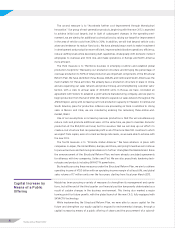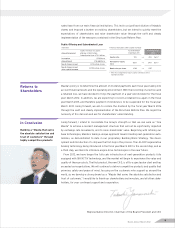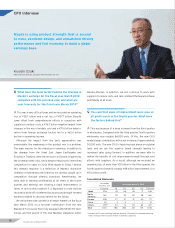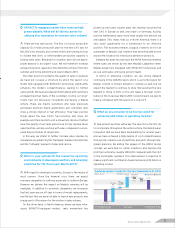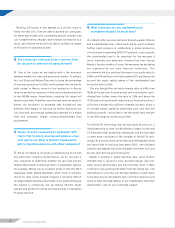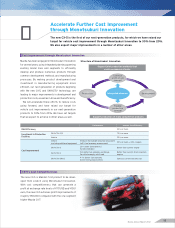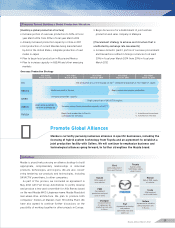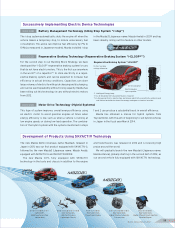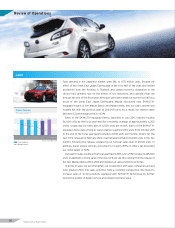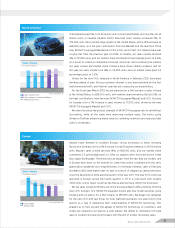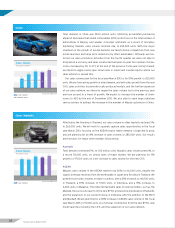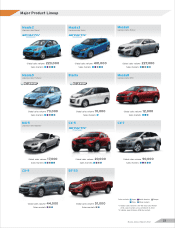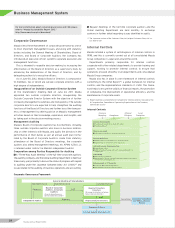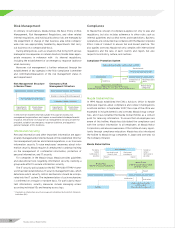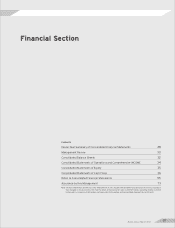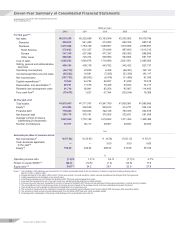Mazda 2012 Annual Report Download - page 20
Download and view the complete annual report
Please find page 20 of the 2012 Mazda annual report below. You can navigate through the pages in the report by either clicking on the pages listed below, or by using the keyword search tool below to find specific information within the annual report.
Improving the Fuel Economy of Mazda Vehicles 30% by 2015
Building Block Strategy
Providing all customers with driving pleasure and outstanding environmental and safety performance
Mazda’s Technologies
Ev in 2020, Mazda expects that the world’s key energy sources
will continue to be mainly petroleum-based, and that the majority
of vehicles will still be powered by internal combustion engines.
With this outlook, Mazda is working on the development of
its Building Block Strategy in order to meet its goal of raising the
average fuel economy of Mazda vehicles sold worldwide by
30% by 2015 compared with 2008 levels.
Rather than rely significantly on a limited number of environ-
mentally friendly vehicles, Mazda has taken an approach of
effectively reducing overall CO2 emissions by providing all
customers with driving pleasure and outstanding environmental
and safety performance. Through rapid advances in base
technologies for basic functions, including in engines, transmis-
sions, bodies, and chassis, we are successively introducing
electric devices like regenerative braking technology and hybrid
systems. We refer to this as our Building Block Strategy.
Electric
devices
Internal
combustion
engines
Base engines
(Internal combustion
engines)
Electric
devices
Internal
combustion
engines
Base engines
(Internal combustion
engines)
Electric
devices
Internal
combustion
engines
Base engines
(Internal combustion
engines)
Hybrids
Regenerative braking
Idling stop systems Hybrids
Plug-in hybrids
Regenerative braking
Hybrids
Plug-in hybrids
Regenerative braking
Idling stop systems
Idling stop systems
Anticipated Expansion in Adoption of Environmental Technologies (Through 2020)
Graphic representation of global market share of powertrain technologies
2010 2020
2015
Electric vehicles Electric vehicles Electric vehicles
• Introduction of hybrid technology and
idling stop technology
• Expand use of electric device technologies and
increased introduction of electric vehicles
• Stricter fuel efficiency standards globally
• Need for big boost in energy efficiency
• Expanded adoption of electric device technologies
New-generation technologies—SKYACTIV Technology
Providing all customers with driving pleasure and outstanding environmental and safety performance
New-generation direct-injection
gasoline engine
SKYACTIV-G
New-generation clean diesel engine
SKYACTIV-D
New-generation transmissions
SKYACTIV-DRIVE
SKYACTIV-MT
New-generation platform
SKYACTIV-Body
SKYACTIV-Chassis
Step-1 Battery Management Technology (Idling stop system i-stop)
Step-2 Regenerative Braking
Step-3 Electric Drive Technology (Hybrid System)
Base technologies
Weight reduction (100kg or more for the whole vehicle)
Mazda’s Building Block Strategy
Technical Superiority of SKYACTIV
Improvement in fuel consumption due to engine
New-generation gasoline engine SKYACTIV-G
New-generation diesel engine SKYACTIV-D
Improvement in fuel consumption due to transmission
New-generation automatic transmission SKYACTIV-DRIVE
Improvement in fuel consumption due to reduced weight
More than 100kg lighter than
previous models
Reduction in aerodynamic drag and
other rolling resistance
Improvement in fuel consumption due to electrical devices
Idling stop system i-stop
Regenerative braking system i-ELOOP
Improvement
in fuel
consumption
about
30% (–2015)
Mazda Annual Report 2012
18


